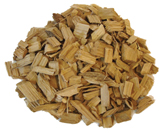 Soft, silky, velvety, youthful, puckery, aggressive, harsh, bitter, astringent: These are all adjectives used in winespeak to describe the many taste sensations from tannins in red wines.
Soft, silky, velvety, youthful, puckery, aggressive, harsh, bitter, astringent: These are all adjectives used in winespeak to describe the many taste sensations from tannins in red wines.
So what’s the difference between all these descriptors? We’ll answer this question by looking at where the different types of tannins originate and how they get into wine, ways of managing tannin extraction from grapes, how they affect wine style, the difference between “good” and “bad” tannins, how tannins evolve over time, and how they affect taste and sensations.
What are tannins?
Tannins are substances widely distributed in plants where they serve as defense mechanisms against predators. Chemically, tannins belong to a large class of compounds known as phenolics or polyphenols, and indeed, they impart bitterness and astringency. Other well-known phenolics include anthocyanins, which are responsible for color in flowers, fruits and red wine, and although odorless and nearly flavorless, they do impart an astringent sensation.
But although bitterness and astringency are caused by tannins binding with proteins in our saliva when drinking wine, the two should not be confused. Bitterness refers to one of the five basic flavors (the others being sweetness, saltiness, acidity and umami) while astringency refers to the tactile sensation of dryness and roughness in the mouth. Their effects are a function of the degree of polymerization, i.e. how big tannin molecules become, from winemaking and aging. Small molecules are believed to impart bitterness while big molecules are said to impart astringency. Since tannins are extracted as small molecules and then polymerize into medium and big molecules during aging, the bitter taste evolves to a less bitter taste but more astringent sensation to one of mostly astringency. That’s because our salivary proteins cannot accommodate (i.e. bind to) those large molecules.
Not all tannins are created equally. The two main sources of tannins in red wine are grapes and oak barrels, but if we dissect a grape berry and stems, we will find very different types and polymerization of tannins. Which ones are desirables and which ones aren’t? To answer this question, let’s examine the three classes of tannins: hydrolyzable, condensed, and complex.
Hydrolyzable tannins
The class of hydrolyzable tannins, so called because the compounds are attached to sugar molecules and which can be cleaved, or hydrolyzed, into their subcomponents, gallotannins and ellagitannins. These are relatively soft tannins found in low concentrations in grape juice; the ellagitannins castalagin and vescalagin are found abundantly in the woody Quercus (oak) and Castanea (chestnut) plant species. That’s why chestnut barrels were once popular only to succumb to the now more popular oak barrels or oak adjuncts, such as staves, cubes and chips, which impart additional and more favorable aromas and flavors. And if you want to add a more pronounced yet rounder mouthfeel, add a tannin mix specifically formulated with gallotannins and ellagitannins.
Condensed tannins
The class of condensed tannins, so called because of their ability to polymerize or bind with anthocyanins, and also referred to as proanthocyanins, are found in seeds and to a lesser extent in stems, and relatively little in the skin of red grapes. In general, you can expect that the thicker and the more colored the grape skin, the higher the concentrations of tannins and anthocyanins.
Condensed tannins are all derivatives of a flavanol (a class of compounds found in plants and certain fruits and vegetables) known as catechin. Catechins found in seeds and stems are very bitter and astringent, particularly because of their much smaller degree of polymerization, compared to the beneficial ones found in the skins; that’s why grapes are usually destemmed prior to crushing and why crushing of or extended contact with seeds should be avoided.
Since there is no maceration of juice with grape solids in white winemaking, tannin content in unoaked whites is negligible; however, red winemaking is all about maceration. There are some interesting chemical properties of and interactions between catechins and anthocyanins at play during maceration and fermentation that need to be managed to produce a desired style of wine.
So let’s look at some specific winemaking techniques to control the amount of catechins and anthocyanins extracted into wine. The extent of extraction depends on phenolic ripeness of the grapes — that is, the amount of phenolics in grapes, which depends on viticultural practices, soil condition, and climatic conditions of the growing region and season — and winemaking practices such as cold soak maceration, fermentation environment, duration of skin contact during maceration and fermentation, cap management and extended post-ferment maceration.
Tannin extraction techniques
First, because it is worth repeating, destem grape bunches. You want to remove as much of the stems as possible, particularly very green (as opposed to brownish) stems. Catechins in stems are very harsh and will require years to mellow out before the wine is approachable.
Second, anthocyanins are more soluble in grape juice than in alcohol (i.e. wine), whereas catechins are more soluble in alcohol than in water. To extract more anthocyanins for a deeper color, perform a cold soak maceration before fermentation.
Cold soak maceration involves soaking grape solids in the juice for several days to a week at a cold temperature, down to 45 °F (7 °C) or preferably lower to ensure fermentation does not start on its own. Sulfite lightly at crush, up to 25 mg/L, to minimize bleaching effects of sulfite, which would go counter to your objective of extracting more color, and to minimize catechin extraction. And be sure to perform daily punchdowns to stimulate anthocyanin extraction and to reduce any risk of bacterial infections.
During cold soak maceration, there will be some extraction of skin catechins, but these are also precursors to browning reactions in the presence of oxygen (air), and so, their extraction should be limited until fermentation is started — fermentation provides protection against browning by deactivating the culprit enzymes. This is usually not a problem but, again, do not over-sulfite as that would otherwise hasten catechin extraction and increase the risk of browning during maceration.
Third, opt for a relatively hot and quick fermentation to favor extraction of catechins from the skins and to minimize contact time with seeds. Anthocyanin extraction will continue, albeit, at a much slower pace. A typical fermentation should last five to seven days until dryness (when the SG/Brix read 0.995/-1.5). If you want to minimize catechin extraction because you intend to drink the wine early, rack the wine earlier, say at an SG/Brix of 1.030/7.5, and then press. And fermentation temperature should never exceed the mid-80s °F (below 30 °C), which could otherwise result in a stuck fermentation.
Fourth, only perform a (cold) post-ferment maceration if you intend to create a rich, bold, full-bodied style of red meant for aging. During this phase of winemaking, extended contact with seeds will hasten extraction of harsher catechins.
Alternatively, perform delestage during fermentation to remove as much seeds as possible if you want to do a post-ferment maceration to extract more skin catechins. Delestage is a two-step “rack-and-return” process whereby fermenting red wine juice is separated from the grape solids by racking and then returned to the fermenting vat to re-soak the solids, and then repeated daily.
Complex tannins
Tannins continue to evolve over the course of the life of a wine, both in bulk in carboys or barrels and in bottles. During aging, both hydrolyzable and condensed tannins polymerize into large, high-molecular weight complex tannins that also bind to anthocyanins and precipitate as tannin-anthocyanin complexes, resulting in a lighter color and reduced bitterness over time. This reaction and sedimentation occurs over a long period of time depending on wine chemistry and storage conditions.
Tannin-anthocyanin complexes are too large to pass through a filter medium and can therefore be filtered out to achieve the same level of clarity as extended aging without filtration. But filtration naysayers argue that other critical compounds are also filtered out — which ones, we don’t know — and that is the essence of the debate regarding the quality of filtered vs. unfiltered wine.
Tannin benefits
One benefit of tannins is that they act as natural fining agents by binding to and precipitating haze-causing proteins. Protein stability in tannic red wines is therefore not of concern; however, wines processed very quickly (for early drinking) with little or no tannin extraction (such as whites) should still be tested for protein stability before bottling.
But the single, most important benefit of tannins is that they are natural antioxidants — a red wine’s aging potential is largely based on its tannin content. Tannins have an affinity for binding to oxygen to protect wine from the effects of oxidation. By restricting the availability of dissolved oxygen to oxidation-prone compounds, less oxygen is available, for example, to transform phenolics into browning compounds and alcohol into acetaldehyde, a common spoilage compound.
Taming tannins
There are a number of possible solutions if you have extracted excessive tannins, all very effective. The extent of tannin “removal” depends largely on timing, i.e. trying to remove small vs. large molecules, and concentration.
Tannins have a strong affinity for proteins, and so, you can fine using a protein-containing fining agent such as egg whites, gelatin, or isinglass. Since gelatin comes in different formulations, i.e. low vs. high molecular weight, choose the one that best fits your needs based on the manufacturer’s recommendations, and avoid overfining. Gelatin formulations with different molecular weights show preferential affinity for tannin size.
PVPP, short for polyvinylpolypyrrolidone, is a highly insoluble, high-molecular weight synthetic polymer that is effective in absorbing and precipitating small tannins. And so, PVPP is recommended for early-drinking wine or where bitterness needs to be toned down.
Another potential solution is gum arabic (gum acacia), a natural gum extracted from the sap of specific species of African Acacia trees. It is very effective in reducing tannin astringency and increasing the perception of body or volume, and reducing the perceptions of acidity and tannin harshness, while adding body.
And lastly, you can tame tannins by readjusting the wine balance by tweaking sugar and acidity contents. I often repeat Émile Peynaud’s guidelines; keep them in mind when tweaking your wine. “A wine tolerates acidity better when its alcoholic degree is higher; acid, bitter and astringent tastes reinforce each other; the hardest wines are those which are at the same time acid and also rich in tannins; a considerable amount of tannin is more acceptable if acidity is low and alcohol is high. The less tannic a red wine is, the more acidity it can support (necessary for its freshness); the richer a red wine is in tannins (necessary for its development and for its longevity) the lower should be its acidity; a high tannin content allied to a pronounced acidity produces the hardest and most astringent wines.”




